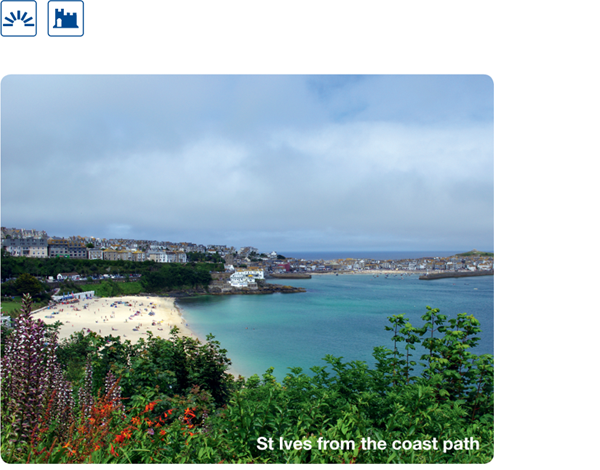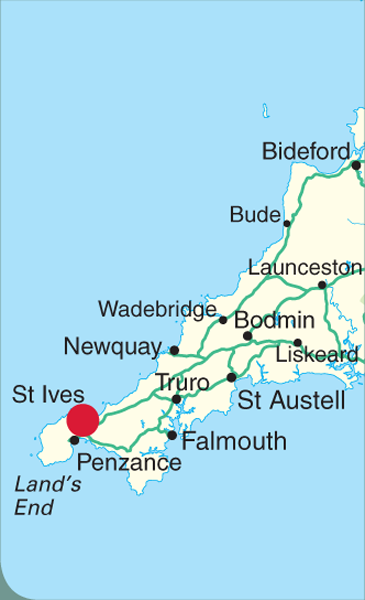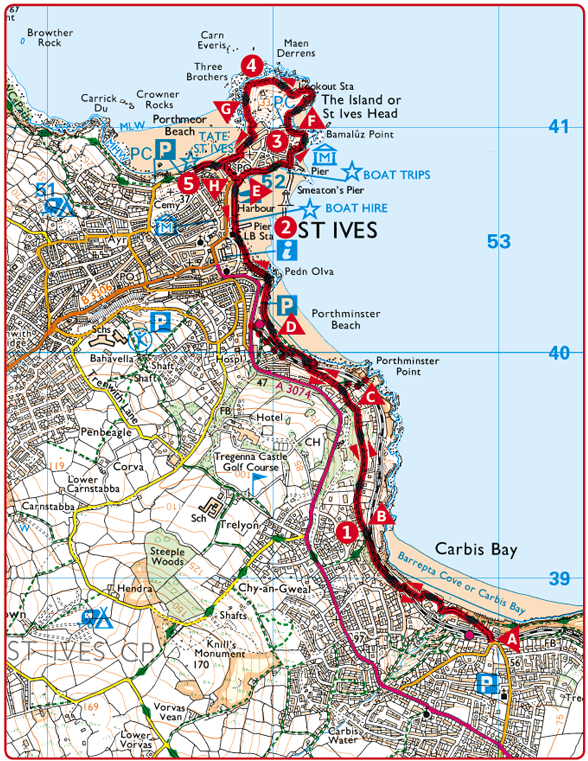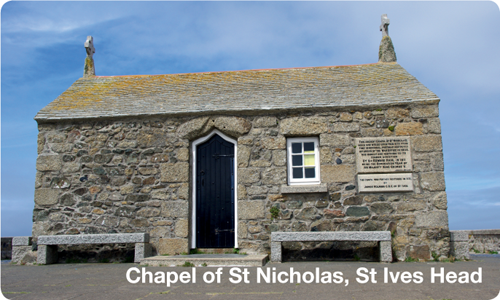

Plan your walk |
|
 |
DISTANCE: 3 miles (4.75km) TIME: 2 hours START/END: SW528387 Carbis Bay rail station car park. The singletrack St Ives Bay Line runs regularly throughout the day and evening, hugging the coast between St Erth and St Ives. Plan ahead with a timetable available online or locally, and check return train times at the station when you park. TERRAIN: Easy MAPS: |
 Park at Carbis Bay rail station car park. Turn left out of the car park and go down the road to Carbis Bay beach. Take the path between the Sands Café and the Carbis Bay Hotel and follow it around the hotel to cross the footbridge over the railway.
Park at Carbis Bay rail station car park. Turn left out of the car park and go down the road to Carbis Bay beach. Take the path between the Sands Café and the Carbis Bay Hotel and follow it around the hotel to cross the footbridge over the railway.
 Continue along the path, going straight on when it joins a narrow lane. On your left you pass The Baulking House.
Continue along the path, going straight on when it joins a narrow lane. On your left you pass The Baulking House.
 The white-painted Baulking House is a former fisherman’s lookout from where the ‘huer’ watched for shoals of pilchards in the bay so he could alert townsfolk below to launch their fishing boats.
The white-painted Baulking House is a former fisherman’s lookout from where the ‘huer’ watched for shoals of pilchards in the bay so he could alert townsfolk below to launch their fishing boats.
 As the lane bends to the left take a short detour to the right, down a road marked ‘Private Road Pedestrians Only’ for a panoramic view of Porthminster Beach and St Ives. Retrace your steps to continue downhill on the signposted path. Cross the railway bridge and at the path junction take the way ahead as it drops down to Porthminster Beach.
As the lane bends to the left take a short detour to the right, down a road marked ‘Private Road Pedestrians Only’ for a panoramic view of Porthminster Beach and St Ives. Retrace your steps to continue downhill on the signposted path. Cross the railway bridge and at the path junction take the way ahead as it drops down to Porthminster Beach.
 For an immediate return journey by train, climb the steps on your left to the railway station. Alternatively continue along the beachfront to the centre of St Ives.
For an immediate return journey by train, climb the steps on your left to the railway station. Alternatively continue along the beachfront to the centre of St Ives.
 St Ives is one of the best-known Cornish resorts. The town is named after the Irish St Ia who landed here in AD460 on a Christian mission and St Ives grew up around the small 6th century chapel of St Ia. The livelihood of the town depended on pilchard fishing until the 1890s when the coming of the railway made it a popular holiday and residential town. John Smeaton, the famous builder of the third Eddystone Lighthouse, constructed the harbour in 1770 and St Leonards Chapel on the pier is the traditional chapel for St Ives fishermen. It is easy to see why this picturesque and colourful port has attracted artists for generations, making it famous as an artistic centre. There is a wealth of art studios and small galleries to visit, as well as the internationally acclaimed Tate.
St Ives is one of the best-known Cornish resorts. The town is named after the Irish St Ia who landed here in AD460 on a Christian mission and St Ives grew up around the small 6th century chapel of St Ia. The livelihood of the town depended on pilchard fishing until the 1890s when the coming of the railway made it a popular holiday and residential town. John Smeaton, the famous builder of the third Eddystone Lighthouse, constructed the harbour in 1770 and St Leonards Chapel on the pier is the traditional chapel for St Ives fishermen. It is easy to see why this picturesque and colourful port has attracted artists for generations, making it famous as an artistic centre. There is a wealth of art studios and small galleries to visit, as well as the internationally acclaimed Tate.

 Follow the road round the harbour, turning left at Smeaton’s Pier. Keep to the sea wall, passing the museum on your left.
Follow the road round the harbour, turning left at Smeaton’s Pier. Keep to the sea wall, passing the museum on your left.
 The traditional style St Ives Museum is run by enthusiastic volunteers and is a treasure trove collection of all kinds of artefacts related to local history, farming, fishing, lifeboats, shipwrecks and mining. The site of the museum has a long history including use as a chapel, pilchard-curing cellar and as accommodation for shipwrecked mariners.
The traditional style St Ives Museum is run by enthusiastic volunteers and is a treasure trove collection of all kinds of artefacts related to local history, farming, fishing, lifeboats, shipwrecks and mining. The site of the museum has a long history including use as a chapel, pilchard-curing cellar and as accommodation for shipwrecked mariners.
 Continue following the sea wall round the small beach of Porthgwidden, then take the path up from the car park to climb the headland of the Island.
Continue following the sea wall round the small beach of Porthgwidden, then take the path up from the car park to climb the headland of the Island.
 At the top of the Island there are panoramic views along the coast. The National Coastwatch Institution runs the watch station voluntarily. The adjacent remains of battery fortifications were built in 1860 to guard against a possible French invasion by Napoleon. The original chapel of St Nicholas was destroyed and the existing building dates from 1911.
At the top of the Island there are panoramic views along the coast. The National Coastwatch Institution runs the watch station voluntarily. The adjacent remains of battery fortifications were built in 1860 to guard against a possible French invasion by Napoleon. The original chapel of St Nicholas was destroyed and the existing building dates from 1911.
 Take the path back down the headland and turn right to follow the road, or alternatively walk along the beach, to the Tate St Ives gallery facing onto Porthmeor Beach.
Take the path back down the headland and turn right to follow the road, or alternatively walk along the beach, to the Tate St Ives gallery facing onto Porthmeor Beach.
 Tate St Ives is a landmark white building, opened in 1993. Housing the finest modern and contemporary paintings, sculptures and ceramics, it also hosts family activities and interactive talks.
Tate St Ives is a landmark white building, opened in 1993. Housing the finest modern and contemporary paintings, sculptures and ceramics, it also hosts family activities and interactive talks.
 Follow the narrow streets back to the harbour, taking time to wander the colourful streets of the town before retracing your steps along the harbour and back to the railway station.
Follow the narrow streets back to the harbour, taking time to wander the colourful streets of the town before retracing your steps along the harbour and back to the railway station.
